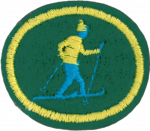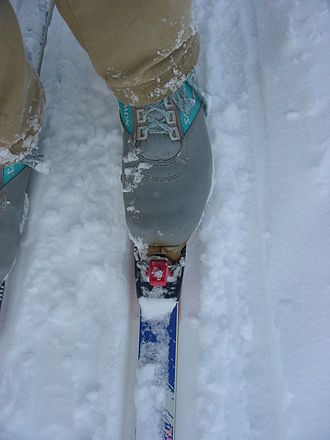Especialidades JA/Esquí de fondo
| Esquí de fondo | ||
|---|---|---|
| Asociación General
|
Destreza: 2 Año de introducción: 1986 |
|
Requisitos
|
La especialidad de Esquí de fondo es un componente de la Maestría Recreación. |
1
1a
1b
Salomon Nordic System Profil
Salomon Nordic System (SNS) bindings, made by Salomon and Atomic, however, have their advantages too. Boots that are compatible with the SNS Profil system are made by Salomon, Atomic, Adidas, and Hartjes. SNS Profil bindings are used for both Skating and Classic. As opposed to the SNS Pilot's two axes, these boots have only one axis at the front of the sole. Pilots are used by many different racers on the World Cup Circuit. Profil bindings are the standard binding for SNS users, its only competition being the SNS Pilot system. Profil comes in "Equipe" models for racing, "Active" for recreational racing/combination, Auto Touring, and Back Country. Fischer was for many years synonymous with SNS as well, but switched to the more widely used NNN for the 2007/2008 season and beyond.
Salomon Nordic System Pilot
SNS Pilot bindings, compatible with Salomon, Atomic, Adidas and Hartjes boots. As of the 2006/2007 season, Atomic will also have SNS pilot on their boots. The idea for these bindings came from Bjørn Dæhlie. Pilots are used mostly by elite skiers at the Collegiate/Olympians/World Cup/National level, although it is common to find High School/Citizen Racers with these bindings and their counterpart boots. Pilots are more expensive than Profils at about 100 U.S. dollars for a pair, and have two completely different designs for skate skiing and classical skiing. In Pilot boots, two axes (metal bars), one positioned about 1" (2.5 cm) behind the other, click into two different slots in the Pilot binding. Profil boots only have one axis and therefore cannot fit into Pilot bindings. However, Pilot boots can fit into most Profil bindings, due to a small space behind the front of the boot for the other axis. Pilot Skate bindings are superior to Profil due to the two latches reducing ski motion in the air. The Pilot Classic (released at the end of the 2005-2006 season) doesn't have the bumper found on all NNN and SNS Profil bindings. These new boots and bindings provide a superior subtle kick through a spring loaded back slot for the back axis. Unlike the rubber bumpers, this spring has adjustable tension that can be changed in different snow conditions. Fischer has now started producing their new boots with the NNN system.
1c
1d
2
2a
2b
2c
2d
3
4
4a
4b
4c
4d
4e
4f
4g
4h
4i
4j
5
6
7
8
8a
8b
8c
Referencias
- Categoría: Tiene imagen de insignia
- Categoría:Libro de Respuestas de Especialidades JA/Especialidades
- Categoría:Libro de Respuestas de Especialidades JA
- Categoría:Libro de Respuestas de Especialidades JA/Nivel de Destreza 2
- Categoría: Libro de respuestas de especialidades JA/Especialidades introducidas en 1986
- Categoría:Libro de Respuestas de Especialidades JA/Asociación General
- Adventist Youth Honors Answer Book/Recreation/es
- Adventist Youth Honors Answer Book/Recreation/Primary/es
- Categoría:Libro de Respuestas de Especialidades JA/Etapa 0
- Adventist Youth Honors Answer Book/Recreation Master Award/es
- Adventist Youth Honors Answer Book


